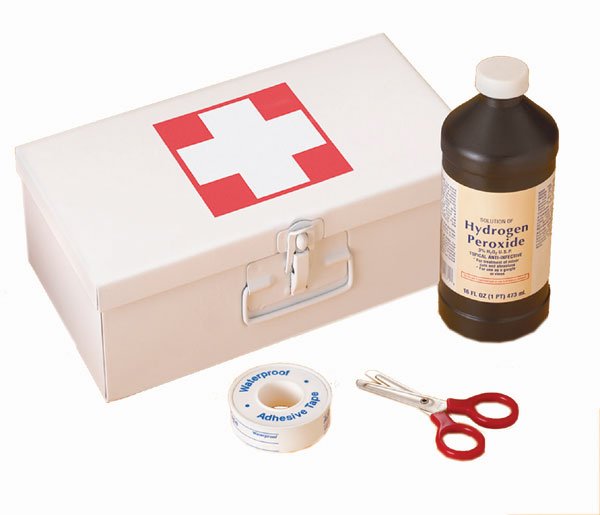Native Californians view earthquakes with a sort of
lackadaisical disdain, unimpressed by the barely perceptible daily
rumbles that shake up and down the state. A 3.2? Yawn. A 3.9 like
the one we experienced Monday? Maybe some office commentary.
All that lack of worry could add up to a serious problem in the
event of a large quake, though.
Native Californians view earthquakes with a sort of lackadaisical disdain, unimpressed by the barely perceptible daily rumbles that shake up and down the state. A 3.2? Yawn. A 3.9 like the one we experienced Monday? Maybe some office commentary.
All that lack of worry could add up to a serious problem in the event of a large quake, though.
In the aftermath of a monster shaker, there might be more to pick up than broken picture frames and toppled books. Being ready now is the best insurance you can provide yourself and your family in the case of emergency.
The first 72 hours after any major disaster are the most difficult. Power, water and sewage systems may all be out, not to mention natural gas lines. Water – one gallon per person per day – and food – canned or boxed non-perishables– are obvious things to have on hand, along with flashlights, batteries and clothing. A battery or crank-operated radio, money and a box of plastic trash bags for everything from dirty laundry to human waste disposal are also good to have on hand.
Aside from the goods you’ll want to keep in a home, maintaining a family emergency plan and choosing an out-of-state contact will help you to stay more organized and calm in the short term.
“Talk to your kids and do some earthquake drills just like you would do fire drills at home,” said Hollister Fire Marshall Michael O’Connor. “Talk to them about what would happen if you were at work and they were at school. It may take eight or 10 hours before those parents can get back to the school to pick up their kids, but the school will take care of them. They just need to be reassured that mom and dad are going to be coming to get them.”
Some other guidelines you might want to consider:
1. Pick a person outside the state for your emergency contact – a grandmother, friend, cousin – and instruct all family members to check in with that person immediately after the earthquake or other disaster. In the event of phone system failure, long distance lines are generally the first restored after 911 is back on line, said O’Connor. It will be easier to call outside the state than within it .
2. Learn how to turn off your gas, sewer and water supplies, but know that you aren’t required to. Unless you smell or suspect a broken line, don’t turn things off. It will save both you and the utility companies some time if they don’t have to reconnect undamaged services, but if you are suspicious, shut the lines down immediately.
When turning off electrical power, said O’Connor, slowly increase and decrease your consumption by turning off individual fuses first before shutting down the main switch. As you turn power back on, do the same thing in reverse, turning on the main power followed by individual switches.
3. Consider location. If your home should partially collapse or become otherwise unstable, supplies in interior areas may not be accessible.
“Keep your supplies in an area that’s accessible from the outside of the house,” said O’Connor. “If your house is damaged, you might not be able to get to those things inside, especially if they’re in an inside closet or something where the house has collapsed. If things are stored by an exterior door or wall it’s best.”
4. Be savvy about first aid. Keeping a first aid kit in your disaster preparedness stash is helpful, but what if you’re out and about? Keep one in the car as you may be stranded in another city for several hours. Also, consider taking a first aid course. The ability to care for your own family members may be very important if your home is inaccessible for some reason or if medical aid cannot reach you right away.
5. Minimize the number of hazards. Large cabinets, appliances and water heaters should all be tethered to the wall to ensure they stay in place. Water heaters should also be connected to the wall by flexible piping should they move despite restraints.
And as always, seek shelter when a quake begins. Outer doorways are actually safer to stand in than inner doorways, and all doorways have the potential to cause minor injury thanks to fingers getting pinched by door swinging about. The best place to stand, according to O’Connor, is in an uncluttered hallway – they usually have few windows and lots of support. Your kitchen is actually the most dangerous place to be during an earthquake because of the potential for items to fall out of high cupboards. Kitchen cabinets should be fitted with child safety latches to avoid as much damage as possible.
For more information on disaster preparedness, visit the California Office of Emergency Services’ Web site, www.oes.ca.gov.
Emergency Supplies Checklist
Stock up now on emergency supplies for your safety and comfort during and after a disaster. Store enough supplies for at least 72 hours.
Essentials
• Water – 1 gallon per person per day (a week’s supply of water is preferable)
• Water purification kit
• First aid kit, freshly stocked
• First aid book
Food
• Can opener (non-electric)
• Blankets or sleeping bags
• Portable radio, flashlight and spare batteries
• Essential medications
• Extra pair of eyeglasses
• Extra pair of house and car keys
• Fire extinguisher – A-B-C type
• Food, water and restraint (leash or carrier) for pets
• Cash and change
• Baby supplies: formula, bottle, pacifier, soap and baby powder, clothing, blankets, baby wipes, disposable diapers, canned food and juices.
Sanitation Supplies
• Large plastic trash bags for waste; tarps and rain ponchos
• Large trash cans
• Bar soap and liquid detergent
• Shampoo
• Toothpaste and toothbrushes
• Feminine hygiene supplies
• Toilet paper
• Household bleach
• Safety and Comfort
• Sturdy shoes
• Heavy gloves for clearing debris
• Candles and matches
• Light sticks
• Change of clothing
• Knife or razor blades
• Garden hose for siphoning and firefighting
• Tent
• Communication kit: paper, pens, stamps
Cooking
• Plastic knives, forks, spoons
• Paper plates and cups
• Paper towels
• Heavy-duty aluminum foil
• Camping stove for outdoor cooking (caution: before using fire to cook, make sure there are no gas leaks; never use charcoal indoors)
• Tools and Supplies
• Axe, shovel, broom
• Adjustable wrench for turning off gas
• Tool kit including a screwdriver, pliers and a hammer
• Coil of 1/2″ rope
• Plastic tape, staple gun and sheeting for window replacement
• Bicycle
• City map
– California Office of Emergency Services












